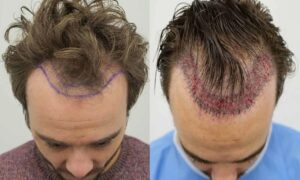Transform Your Hairline A Comprehensive Guide to Hair Transplant Options in India

Hair transplant is a surgical procedure that involves the extraction of hair follicles from a donor area, typically the back or sides of the head, and their transplantation into areas with thinning or no hair. This procedure offers a permanent solution for individuals experiencing hair loss or receding hairlines.
Welcome to “Transform Your Hairline: A Comprehensive Guide to Hair Transplant Options in India.” This guide aims to provide you with valuable information about hair transplants, specifically in the context of India and different Indian Cities. If you are considering a hair transplant procedure to enhance your hairline, then you can get best hair transplant in Mumbai, this guide will equip you with the knowledge you need to make informed decisions.
Hair Transplant Options in India
Hair loss is a common problem that affects millions of people worldwide. It can have a significant impact on one’s self-esteem and confidence. However, with advancements in medical technology, there are now various hair transplant options available to individuals seeking a permanent solution to their hair loss. India, in particular, has emerged as a popular destination for hair transplant procedures, offering a range of options to cater to different needs and budgets.
- Follicular Unit Extraction (FUE) – Follicular Unit Extraction (FUE) is a minimally invasive hair transplant technique that involves extracting individual hair follicles from the donor area and implanting them into areas with hair loss. It is performed using a specialized punch tool without the need for a linear incision or sutures, resulting in less scarring. FUE provides natural-looking results and a faster recovery compared to traditional methods. It is a popular choice for those seeking effective hair restoration with minimal downtime and excellent cosmetic outcomes.
- Follicular Unit Transplantation (FUT) – Follicular Unit Transplantation (FUT) is a hair restoration technique that involves harvesting a strip of scalp from the donor area and dissecting it into individual follicular units. The units are then transplanted into the areas experiencing hair loss. FUT requires a linear incision, which is closed with sutures, leaving a thin scar that can be concealed by surrounding hair. This method allows for the transplantation of a larger number of grafts in a single session and is suitable for patients requiring extensive hair restoration.
- Direct Hair Implantation (DHI)- Direct Hair Implantation (DHI) is an advanced hair transplant technique that involves the direct extraction and implantation of individual hair follicles using a specialized tool called a Choi implanter pen. Unlike other methods, DHI allows for the simultaneous extraction and placement of grafts, minimizing the time they are outside the body. This technique enables precise control over the angle, direction, and depth of each hair follicle, resulting in natural-looking and dense hair growth. DHI is a popular choice for patients seeking a minimally invasive procedure with minimal downtime and excellent aesthetic outcomes.
- Robotic Hair Transplantation- Robotic Hair Transplantation is an innovative procedure that utilizes advanced robotic technology to assist in hair transplantation. It involves the use of a robotic system to extract individual hair follicles from the donor area and implant them into the recipient area with precision and accuracy. The robotic system uses artificial intelligence and image-guided technology to identify and select the optimal grafts for transplantation. This automated approach ensures consistency, reduces human error, and allows for a faster and more efficient procedure.
- Synthetic Hair Transplantation– Synthetic Hair Transplantation is a hair restoration technique that involves the implantation of artificial or synthetic hair fibers into the scalp. These fibers are designed to mimic the appearance and texture of natural hair. Synthetic hair transplantation is an alternative for individuals with limited donor hair or those who prefer a non-surgical option. While it provides immediate results, it does not offer the same long-term durability as natural hair transplant methods.
The Hair Transplant Procedure
The hair transplant procedure can be summarized in the following points:
- Donor Area Harvesting
- The donor area, typically the back or sides of the scalp, is identified and prepared for harvesting.
- Hair follicles are extracted from the donor area using either the FUE or FUT technique
- FUE involves individual extraction, while FUT involves removing a strip of scalp for dissection into follicular units.
- Graft Preparation:
- The extracted hair follicles are carefully dissected into individual grafts under a microscope
- Grafts are sorted based on their size and quality, ensuring optimal transplantation results
- This preparation stage is crucial for achieving natural-looking hair growth in the recipient area
- Recipient Area Preparation:
- The recipient area, where hair loss or thinning occurs, is cleaned and prepared for graft implantation.
- Tiny incisions or recipient sites are made in a strategic pattern, considering the hairline and natural hair growth pattern.
- The recipient area’s density and angle are carefully considered for a seamless integration with existing hair.
- Graft Implantation:
- The prepared grafts are delicately inserted into the recipient sites using specialized instruments or robotic assistance.
- The surgeon ensures proper placement, considering the direction, angle, and density for natural-looking results.
- Post-Procedure Care:
- Patients are provided with post-operative instructions for optimal healing and hair growth.
- Medications, such as antibiotics or pain relievers, may be prescribed to manage any discomfort or potential infection.
- Regular follow-up appointments are scheduled to monitor progress and address any concerns during the recovery period
Conclusion: Hair transplant options in India offer individuals a reliable and effective solution for hair loss. With advanced techniques, skilled surgeons, and cost-effective options, India has become a sought-after destination for those seeking to restore their hair and regain their confidence. By understanding the different hair transplant techniques, selecting the right clinic and surgeon, and having realistic expectations, individuals can achieve natural-looking, long-lasting results.








